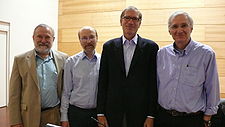- Molecular Biology of the Cell (textbook)
-
For the journal by The American Society for Cell Biology, see Molecular Biology of the Cell.
Molecular Biology of the Cell 
Authors Peter Walter, Julian Lewis, Alexander Johnson and Martin Raff (from left to right)Author(s) Bruce Alberts, Alexander Johnson, Julian Lewis, Martin Raff, Keith Roberts, Peter Walter Subject(s) Cell biology Publisher Garland Science Publication date December 2007 Pages 1392 pp (fifth edition) ISBN ISBN 9780815341055 (hardcover), ISBN 9780815341062 (softcover) Dewey Decimal 571.6 22 LC Classification QH581.2 .M64 2008 Molecular Biology of the Cell is a cellular and molecular biology textbook published by Garland Science and currently authored by Bruce Alberts, Alexander Johnson, Julian Lewis, Martin Raff, Keith Roberts and Peter Walter. The book was first published in 1983 and is now in its fifth edition. James Watson contributed to the first three editions.
Molecular Biology of the Cell is widely used in introductory courses at the university level and is considered a reference in libraries and laboratories around the world. It describes the current understanding of cell biology and includes basic biochemistry, experimental methods for investigating cells, the properties common to most eukaryotic cells, the expression and transmission of genetic information, the internal organization of cells, and the behaviour of cells in multicellular organisms[1]. The latest edition, published in 2007, has been updated to include recent advancements in the field of cell biology, including epigenetics, stem cells, RNAi, comparative genomics and the latest cancer therapies[2]. Molecular Biology of the Cell has been described as “the most influential cell biology textbook of its time”[3].
The fourth edition can be searched at the National Center for Biotechnology Information bookshelf.
Table of Contents
Part I - Introduction to the Cell
2. Cell Chemistry and Biosynthesis
3. Proteins
Part II - Basic Genetic Mechanisms4. DNA, Chromosomes, and Genomes
5. DNA Replication, Repair, and Recombination
6. How Cells Read the Genome: From DNA to Protein
Part III - Methods8. Manipulating Proteins, DNA, and RNA
Part IV Internal Organization of the Cell11. Membrane Transport of Small Molecules and the Electrical Properties of Membranes
12. Intracellular Compartments and Protein Sorting
13. Intracellular Vesicular Traffic
14. Energy Conversion: Mitochondria and Chloroplasts
15. Mechanisms of Cell Communication
16. The Cytoskeleton
17. The Cell Cycle
18. Apoptosis
Part V - Cells in their Social Context19. Cell Junctions, Cell Adhesion, and the Extracellular Matrix
20. Cancer Chapters
21. Sexual Reproduction: Meiosis, Germ Cells, and Fertilization
22. Development of Multicellular Organisms
23. Specialized Tissues, Stem Cells, and Tissue Renewal
24. Pathogens, Infection, and Innate Immunity
25. The Adaptive Immune System
References
- ^ Garland Science Website - http://www.garlandscience.com/textbooks/0815332181.asp
- ^ Taylor and Francis Website - http://www.taylorandfrancis.co.uk/shopping_cart/products/product_detail.asp?sku=&isbn=9780815341116&parent_id=&pc=/shopping_cart/search/search.asp
- ^ Friedberg, Errol C. (2004). The Writing Life of James D. Watson. Cold Spring Harbor Laboratory Press.
External links
Categories:- Biology books
- 2007 books
Wikimedia Foundation. 2010.
